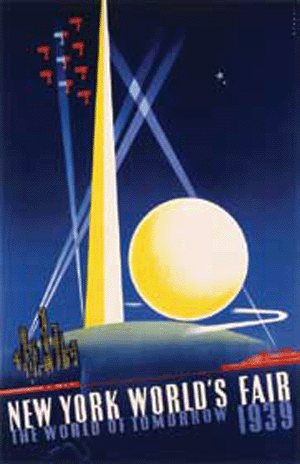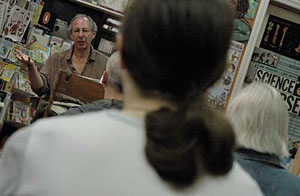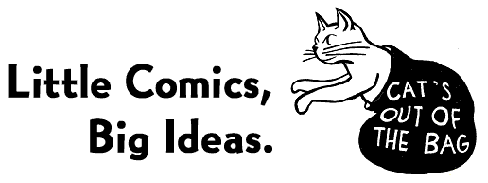| Michael Steinberg, “The Architecture of Dreamworld 1: Like a Sex Machine” (31 October 2005); “The Architecture of Dreamworld 2: The Disarming Reflex” (17 November 2005); “The Architecture of Dreamworld 3: Going Postal” (28 December 2005) |
There’s probably no way to make critical generalizations about popular culture without sounding like a curmudgeon. As I look over Parts 1, 2, and 3 of “The Architecture of Dreamworld,” I wonder, at times, if I’ve done anything more than add a few unnecessary drops to an ocean of elitist condemnation.
Yet there does seem something unique about the state of today’s popular arts and the image culture that surrounds us. Part of it is the increasing tendency to evoke or depict an achieved state, a realm without time or change. Perpetual youth and sexiness, the eternally happy family, and the golden age of peace secured by the defeat of evil — through their evocations, any openings towards process and transformation are pushed aside, aided by the adroit manipulation of biochemical responses, of a floating and unrooted perfection. The narrative impulse has lost its strength.
It surely isn’t a coincidence that over the same period our sense of historical possibility has faded, too. Take the slogan of the World Social Forums: “Another world is possible.” Think for a moment about the context it implies.
It’s a lovely slogan but a very strange one, because it challenges us to embrace the mere idea of social change. The concept of historical possibility has itself become contentious. Never mind particular demands and hopes; first we have to convince others (and probably ourselves, too) that those demands and hopes could actually be realized.
We all live today under the spell of Margaret Thatcher’s mantra TINA — “There Is No Alternative.” Capitalism is the only game in town. And the social democratic parties that have survived have acted accordingly, hitching their wagon to the demands of capital in the hopes that some taxable crumbs will be left to finance the tattered remnants of their welfare programs.
It’s hard to recall how different life was seventy or even sixty years ago. Back in the nineteen-thirties there was no shortage of radical plans for world betterment. The Communist model was the most obvious, but as horrible as Fascism was, it too was a program to remake the world. In the U.S. the New Deal began with hopes of lasting, profound changes in American life. In its early days, for example, the Tennessee Valley Authority built model communities and encouraged cooperative industries, supporting them with cheap public power.
 The 1939 World’s Fair Poster |
Even the commercial exhibitors at the 1939 New York World’s Fair embraced the theme of “Building the World of Tomorrow.” General Motors’ Futurama, designed by the famous industrial designer Norman Bel Geddes, gave fairgoers a tour of a 1960 America of forests, parks, farms, and radiant cities in the style of Le Corbusier. In The City, shown at the fair by a planners’ organization, the narrator challenges us — over melodramatic cuts between a Pittsburgh slum and a shiny International Style high school in Greenbelt, Maryland — “You take your choice. Each one is real. Each one is possible. . . . Shall we build and rebuild our cities? Can we afford a house, a neighborhood, a city as good as this for everyone? Maybe the question is, can we afford all this disorder? The hospitals, the jails, the reformatories, the wasted years of childhood?”
Through the Second World War, a majority of the American people expected a future of major transformations and significant choices. A 1942 Fortune poll found 25 percent of the respondents in favor of socialism, with another 35 percent professing an open mind. That’s sixty percent of the population willing to consider a drastic change in economic relations.
All that was snuffed out in the decade that followed. Between massive postwar prosperity and McCarthyist repression the possibility of a different future vanished from sight. As Michael Denning points out in his invaluable act of intellectual archaeology The Cultural Front, social critics retreated to the universities and took up less contentious subjects like literary theory, often censoring their own earlier work. By the 1960s the Cold War had turned the rich social discourse of the prewar years into a simple choice between American capitalism and an increasingly sclerotic Communism. Two decades later, after the Soviet Union collapsed, even that choice was gone.
Is it any wonder, then, that the aspirations of the prewar public so often found their expression in narrative — and that today the very idea of narrative is as suspect as the idea of change? Narrative implies a future that’s different from the past. Today’s future is nothing but today, repeated endlessly like Bill Murray’s Groundhog Day, but with no hope of even a miraculous return to the world of time. (Evangelical Christianity, perhaps stronger because there is no longer much belief in secular betterment, does offer an escape, but to another world altogether.)
An achieved, permanent capitalism throws up images of its own mythical perfection and permanence, and the emotional weight that pours into the popular arts tends to realize itself in the same forms. Instead of an ideological program of reconciliation with the progress of capitalism, they end up employing some of our deepest impulses to vivify a delusion of present satisfaction.
One could say that Freud was wrong — civilization isn’t built on the suppression of instincts or drives. These days it works by invoking them and keeping us all mesmerized by them. Daydreams of sex, of family, and of vengeance keep us from noticing our own misery, and they let the machinery of capitalism grind on through the small patches of earth and of human life that are left.
Yet at the same time the new dreamworld is vulnerable. Its ideological themes are no longer so woven into the actual processes of social life as to be hard to tease out, so it is easier to see as the fraud that it is. One can doubt the promise of a better future, but it can’t be conclusively disproved until the future arrives. It’s not hard at all, though, to see that life today is nothing like the way it looks in the commercials, even in the capitalist metropolis.
Criticism, however, is not going to be enough to dislodge these illusions. It is more necessary than ever to rekindle the sense that people make their own lives and together can make different ones. The WSF slogan is not inapt; we need to claim that another world is possible, and probably learn that for ourselves, too. We need a future. And for that we need utopians. We even need dreamers. Perhaps we need them most of all. The only way to banish dreamworld is to allow ourselves to dream the future.
Michael Steinberg is the author of The Fiction of a Thinkable World: Body, Meaning, and the Culture of Capitalism published this year by Monthly Review Press and essays in professional journals in history, music, and law. He is a member of the literature collective Cat’s out of the Bag. He and his wife Loret, a photographer and professor of documentary photography, live in Rochester, New York, under the supervision of two domestic medium-hair cats.



